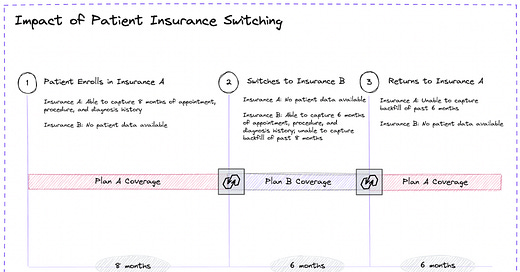Hey Folks, a lot has happened since our last blog post where we talked about our participation in Wharton’s VIP-X Accelerator. Now that we are ready to kick off our fundraise, we’ve decided to jazz things up with our newsletter and publish whenever we run into something we think is cool, weird, or just mind-boggling. We’ll also be featuring insights from other team members at Flagler.
I’ll start off this month…
“Why clearinghouse data is not it for AI & ML”
“AI” and “ML” have been buzz words within the past year, gaining more popularity with the rise of OpenAI. Startups and companies are quick to slap this trendy technology into their bios to join the bandwagon. We’ve seen this theme emerge prominently in the healthcare industry. However, one thing we’ve noted is that many of these companies are relying on clearinghouse data to support their algorithms and analytics. From our experience, we’ve noticed that this type of data just isn’t enough to capture a fully robust visualization of a patient’s medical journey.
For those of you unfamiliar…a clearinghouse helps to process claims on behalf of payors. They’re like the middleman between the physician who submits a claim (for services rendered) and the insurance company (“payor”) who pays the physician for their care.
While you may initially think most, if not all, payors have the full patient picture, they actually don’t. This is mostly due to three reasons:
Patient Consistency: Patients switch jobs or insurance plans more frequently than you’d think, and once they do, the existing insurance provider loses all insights into the patient’s current medical condition/treatment.
Unfun Fact: Every year ~20% of patients switch insurance plans.
Figure 1: Patient switching providers and impact on payor data
Medical Claims Collection Process: Complex contracting structures limit access to medical claims data; this can be due to differences in privacy and data sharing agreements between relevant stakeholders such as medical providers, payors, & clearinghouses
Insurance Types: Employers can choose to offer a self vs. fully insured health plan for employees, which limits one single payor or clearinghouse from capturing all of a patient’s key medical actions.
Figure 2: Visual representation of contracts that exist between each stakeholder
Even the largest healthcare analytics companies in the world, who are contracted with every payor and clearinghouse company under the sun, only have access to ~70% of patient data for the three reasons outlined above.
Of course, you may still have questions that have gone unanswered. If you’d like to read the 8-page write-up we circulated amongst the team, feel free to shoot me an email. The paper also touches on TPAs, reinsurance, and time lag. Just be warned that the paper is much less “spunky”. It’s more academic, with focus on giving a deeper explanation as to why clearinghouse data is not comprehensive and why we here at Flagler go straight to the source.
Now to close off with some fun Flag facts.
Fun Flag Facts
Did you know that Lichtenstein and Haiti had the same flag and only found out at the 1936 Olympics? Afterward, to avoid confusion, a yellow crown was added near the hoist of the blue stripe in the Liechtenstein flag. (This fact actually inspired Sheldon to create the “Fun With Flags” within Big Bang Theory!)Best of Health,






